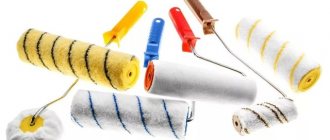Jun 13/17
It seems that there is nothing complicated in choosing a paint roller, but in fact it is an important element for painting that requires special attention. The roller determines how the paint will adhere to surfaces, how convenient it will be to paint, whether it is suitable for reuse, and so on. Not only the dimensions of the handle and the roller itself are important, but also the materials that were used for it.
Therefore, for its readers, “Dream House” has prepared a full review that will help you choose a high-quality paint roller and easily cope with painting any surface and any type of paint.
How to choose a paint roller
Peculiarities
Any type of repair work has its own characteristics, and painting the floor is no exception. Most often, wooden flooring is chosen as flooring. Before you buy paint or varnish for the floor, you need to understand the origin of the existing floor covering. The material used for its manufacture is important when choosing paint or varnish, as well as the means with which the preparatory work will be carried out. You can paint the floor using acrylic, oil, wear-resistant and universal rubber paints.
It is necessary to take into account the characteristics of the room where painting work is planned. The intensity of use, exposure to external factors, average temperature and humidity are very important when selecting paint, since the service life of the painted surface will depend on its properties. If the surface itself has been previously painted, then it is necessary to determine the degree of compatibility of the used paint with the new product.
If the goal is not renewal, but the application of a new layer, then you need to either prime or treat the surface with a special compound before applying the decorative layer.
Options
The first thing you should decide on when buying a paint roller is its width and the diameter of the working surface. There are three main categories to choose from:
1. Universal roller with a width of 100-200 mm, a diameter of 20-90 mm.
This tool is perfect for painting, priming, and processing wallpaper. However, in hard-to-reach places it may not be very convenient, as is the case with large surfaces.
2. Miniature roller up to 100 mm wide, up to 15 mm in diameter.
Ideal for painting small and complex surfaces. Decorating curved areas, artistic finishing - this tool can handle everything. But it is not advisable to buy a small roller for processing walls and ceilings.
3. Large roller with a width of more than 200 mm, a diameter of more than 80 mm.
What you need for painting and processing large areas. Finishing walls or floors with this tool will be quick and easy. For facade work, it is also recommended to buy a wide roller.
The ideal choice here depends on the surface area being treated. The larger the scope of work, the larger the roller should be.
The ability to apply broad strokes allows you to create a more uniform layer with a minimum number of movements - this saves both the time and effort of the artist. At the same time, the dimensions of the tool directly affect its weight, which, for example, can be a significant criterion when painting a ceiling. In such cases, experts recommend buying a wide roller with a small diameter: this way you can at least compensate for the weight of the absorbed material.
The second important nuance is the length of the pile.
It is the pile that largely determines the scope of the painting tool and the features of working with it. So:
- rollers with short pile
(5-6 mm) are best suited for painting/varnishing wood and metal. They use paint and varnish composition sparingly and are very convenient to use; - medium pile
(6-20 mm) absorbs paint much better, so it can be used for processing plasterboard, plaster or concrete. This tool is also useful for painting wood or wallpaper with a weakly defined texture; - rollers with high pile
(more than 20 mm) are most effective for painting porous and uneven surfaces. They are able to cover any holes and irregularities from the first layer, showing excellent performance in the process of both interior and facade work.
What to paint with?
Today, there are various types of paints and varnishes that can be selected for both wooden flooring and concrete floors. There are two types of products that can be used to cover the floor: colorless and opaque. Clear varnishes are great for wooden surfaces. They are durable and fade resistant, and dry quickly. Decorative varnishes have many tones, thanks to which a wooden surface can be given a beautiful shade without blocking the structure of the wood. Beech, oak and other expensive flooring have a beautiful structural pattern, and a varnish with a translucent or transparent consistency will perfectly highlight it, give it shine and protect it from moisture.
It is worth remembering that the varnish is not resistant to various mechanical damage, and therefore it is better not to cover surfaces in rooms with high traffic. Otherwise, it is worth applying additional impregnations.
Do not use this product on flooring made of soft wood (spruce, pine). It is better to treat them with paint that maximally protects the surface from mechanical damage.
Choosing varnish according to the type of room
When selecting a composition for wood flooring, it is necessary to take into account the room in which it will be opened:
- In the bathroom and kitchen, it is better to give preference to mixtures that can withstand moisture. These include polyurethane, urethane-alkyd and urethane varnishes.
- For a children's room, it is necessary to choose polyurethane water-soluble and solvent-soluble compounds, since the toxins present in them are released only during the process of application and drying. Suitable mixtures are marked on the container with the corresponding “EN 71.3” designation.
- For the living room, hall and stairs made of wood, it is necessary to purchase compounds that can withstand abrasion. These include epoxy, urea-formaldehyde, as well as organosoluble and water-soluble mixtures based on polyurethane resins.
- At the dacha, it is optimal to resort to opening the wooden floor with urethane-alkyd and urethane varnishes, which are highly elastic, maintaining their own positive qualities even with significant differences in the size of the wood, which are formed when the temperature and moisture level changes.
- It is advisable to open areas with increased load with urethane varnishes that have an anti-slip effect.
Which paint is better?
Paints of various colors are divided depending on the chemical composition into acrylic, oil, wear-resistant and rubber:
- Non-toxic acrylic paints , which are water-based, perfectly paint over solid wood surfaces. They are quite durable (service life is approximately 10 years), and therefore are in high demand. The components present in the paint are not afraid of temperature changes and high humidity, which means that the paint itself is suitable for use in rooms without heating. There is no pungent odor when painting, and the surface with paint dries quickly.
- rubber paints which are environmentally friendly and safe for the human body , appeared relatively recently, but have already gained popularity. They are characterized by high strength, super elasticity, water resistance and low consumption. The polymers contained in the paint protect the wooden surface from fading and temperature changes.
- Oil paints are inexpensive and extremely common painting materials. They have a uniform consistency and are quite resistant to temperature fluctuations. Having high viscosity, they are ideal for painting OSB panels consisting of glued chip particles. Water-based paints are not suitable for such panels, as there is a high probability of swelling and bending of the slab. Over time, cracks may form on the painted surface. In addition, the paint takes a long time to dry and has a very unpleasant odor.
- Unlike oil-based types, wear-resistant paints are durable. Surfaces with such paint are not afraid of peeling or fading. It is easy to apply a layer, and the paint dries quite quickly. Their smell is quite specific; it disappears from the room only after a few days.
Read also: Selection of machine according to consumer power
Is it possible to paint with a wet roller? Why you can’t paint with a wet roller
At first glance, the job of painting walls with a roller is simple and straightforward. It would seem that you lower the roller into the composition and roll it over the wall. But as with any simple operation, working with a roller has its own nuances. Let's talk about the most common mistakes made by beginners.
What are the dangers of water on a roller? Even if you use water-based compositions diluted to the desired consistency, the water on the roller will change the composition and the paint will become too liquid. That is, in essence, you have diluted the paint even more and at the same time it is not uniform. For this reason, several defects may occur in the resulting decorative layer.
Bubbles on the wall
After painting, the surface swelled, losing adhesion to the base of the wall. The reason lies in excess water in the paint or on the surface. That is, if you are painting wet walls or using highly diluted paint or a wet roller. In most cases, the problem will be resolved after the area has completely dried. That is, just don’t touch it and let the layer dry naturally.
Craters in decorative coating
Have you encountered the fact that when painting, small bubbles remain on the wall, which then burst and the wall becomes rough, covered in shells? There may be several reasons:
Uneven coverage
The wall is primed, the paint is of high quality and diluted in the correct proportions, but the layer turned out to be multi-colored, with different densities. Most likely, the diluent was selected incorrectly. Or there was water on the roller. And if you decide to start painting the walls with a wet roller, using, for example, oil paint, you will end up with not just an uneven layer, but the paint may not even adhere to the base.
Smudges
Paint flowing down in streams is the result of using a highly diluted composition. But the same effect will occur if you apply paint in a thick layer or paint walls in a room with low air temperatures or high humidity levels. And the paint will definitely flow if there was excess water on the roller. The defect should be dispersed before it dries, and if you missed it and didn’t have time, then try rubbing it with fine sandpaper.
Other problems may arise when applying paint, but using a dry, properly selected roller with the right height and density of pile will help avoid a lot of unpleasant surprises.
Color solutions and decor
Gone are the days when only one color was used to paint a floor. Brown paint and several of its shades were produced specifically for wooden flooring. Today, manufacturers produce a wide color palette, thanks to which you can choose absolutely any shade. Water-based paints are especially distinguished by their color range. There are both ready-made options and those that can be given the desired shade using a special colorant. White paint is the base, to which a certain amount of the desired color is added. In order to get the desired shade of paint, you can add several colors.
Matte varnishes also have different colors and shades. With their help, you can give any wood flooring a touch of noble wood. Painting the floor covering can be done using one color or shade, evenly distributing the product over the entire surface. There are special stencil devices with which the surface of the old floor is transformed by applying a pattern. The technology is simple: a stencil with a cut out pattern is applied to the floor surface, and paint is applied to the open areas.
You can use either a sponge or a roller as a tool.
What to consider when choosing and using?
Each type of paint has its own material
So, for primer and antiseptic, you can safely buy an inexpensive roller with any working surface material. Whether it is foam rubber, polyacrylic or polyester is not so important in this case, since these compositions are practically neutral. At the same time, thick varnishes and paints require fluffy coats with high chemical resistance - for oil-based or alkyd-based compositions, only fur and velor rollers are suitable.
Note:
Not only the composition of the coloring material matters, but also its color. So, for applying white paint to the ceiling or walls, a microfiber roller is quite suitable. It is also good for light colors. However, it is better to apply bright, saturated colors with a roller with a higher degree of coverage: at one time such a tool allows you to apply a thick layer of paint, making even a single-layer coating as dense as possible.
A replaceable fur coat is not always good
Today in stores you can easily purchase both a “solid” roller and individual structural elements. This is very convenient, since fur coats tend to quickly become unusable - especially during long-term repairs and, especially, construction work. But you should take into account the fact that the replaceable coat is attached to the roller using special plugs - as a result, traces of seams may remain on the surface to be painted
. This is not always critical, but in many cases the finish runs the risk of becoming more “spectacular” than expected. Therefore, for those who strive for a high-quality and accurate result, it would be more reasonable to buy a regular paint roller with a permanent coat: seamless gluing/thermal welding technology allows you to avoid “surprises”.
Surface matters too
For those who decide to buy a roller for painting the ceiling
, it’s worth taking a closer look at products made of fur, velor or polyamide. Special ceiling rollers with an uneven structure are also produced: their inner layer is denser than the outer one. Thanks to this, the tool distributes the liquid composition most evenly, releasing an additional portion of paint only with stronger pressure. Often, ceiling rollers are also equipped with a semicircular casing designed to protect the painter from falling splashes. To treat high ceilings, it is best to buy a paint roller of this type.
For painting uneven and hard-to-reach surfaces
rollers with a specific design are used. Width-adjustable sliding mechanisms are great for painting large areas, parallel handles are ideal for working in hard-to-reach areas, and swivel designs help when working with pipes.
Textured non-woven wallpaper
It is best to paint with a medium or long pile roller.
Care is important
Throwing the roller in the trash immediately after painting is not a bad idea if you are dealing with a cheap foam product. If the work is carried out with a fleecy, already well-proven tool, it is worth paying a little attention to it. A couple of minutes or a little more - depends on the coloring composition.
So, water-soluble paint can be washed off with running water, preferably warm. To clean a fur coat from aggressive compounds, it is recommended to use “heavier artillery” - solvent or kerosene, and after soaking, wash it in a soapy solution.
It is recommended to dry the roller in a heated room - vertically, hanging or supported by a handle.
Note:
if the tool is planned to be used for re-painting with the same color and composition, there is no need to wash the tool. For 3-4 days it can be wrapped in plastic film or a bag. And after finishing the work, the roller is thoroughly cleaned of all excess.
Need to know where to buy
It’s no secret that today you can buy tools (and more) in an online store without high markups. This is both profitable and convenient. But is there a loss in the quality of the goods? The question is quite reasonable, so you should only trust a reliable store and trusted brands.
The online catalog Valles.ru presents tools from Sherwin-Williams, Maestro, Rexant, Pentrilo, HEADMAN, Fit and many other famous manufacturers. You can buy a paint roller for painting, as well as a textured decorative roller in the online store with fast delivery to any region of Russia.
For all questions, we are waiting for your calls: +7 (861) 241-08-80.
Work technology
Floor painting, like any other job, has its own technology. The final result depends on a competent and consistent approach to this type of activity. Before you begin the process, you need to prepare the tools that may be needed both during the preparatory work and for painting the floor:
- The main tool for covering the flooring is a roller. Today, manufacturers produce a wide variety of rollers of various sizes and materials: foam rubber, polyacrylic, fur, polyamide and even textured. Each type has its own purpose. For painting the floor, the best option is a fur roller marked VMP. They are produced in accordance with GOST and are the most durable compared to foam rubber options, and the layer of paint applied by them will lie evenly.
- To ensure uniform absorption of paint, it is better to purchase a special container with two-level planes. The product is poured into one half, and the other is used to squeeze out the roller.
Surface preparation
Preparatory work is carried out based on the condition of the coating surface. If the flooring is new, then you need to sand the surface well using a sanding machine, then remove dust and debris. If the coating is old, then first remove the paint layer using either a mechanical (using a hair dryer) or chemical (solvent) cleaning method. The resulting cracks are puttied, and after drying the surface is leveled.
If the coating is to be varnished, then there is no need for a primer. Such floorings are treated with special impregnations that protect the wood from mold, fungi and accidental fire. To prepare the floor for painting, use drying oil or a special primer, which gives the flooring antiseptic properties and prepares the surface.
A smooth and level floor with good adhesive properties will greatly facilitate the adhesion of paint to the flooring.
How to paint?
After preparation, you can start painting the floor in the apartment. There is a certain sequence for this stage of work. Before painting, the composition must be thoroughly mixed in a jar to remove clots, and this procedure is carried out regardless of the color (black, white, colored) of the paint. Then you can begin painting the surface adjacent to the walls, starting on the opposite side of the entrance. It is more convenient to do this with a small brush, since it will not be possible to thoroughly paint every corner with a roller.
After applying a layer around the perimeter, you can begin painting the central part of the floor. The applied layer of paint must dry completely, and only then can you begin installing the skirting boards. In order not to stain wallpaper or other facing materials on the walls, you need to cover the part adjacent to the baseboards with masking tape or other available means. Next, you can start painting the baseboards using a narrow brush. After the first layer has dried, a second layer is applied to the baseboards. After waiting the required time for it to dry on the baseboards, you can begin applying paint to the central part of the surface.
When the painted surface is completely dry, you need to prepare the floor for use by washing it thoroughly.
Painting process
Before painting the walls with a roller, it is necessary to protect the surrounding area from accidental ingress of the working substance using a special construction film. It is also necessary to wear protective clothing, safety glasses, gloves, a hat and a respirator. If possible, it is recommended that the area be properly ventilated to remove toxic fumes.
Roller painting technology differs depending on the type of surface
The painting process begins from the top, gradually moving to the lower areas. Before work, it is necessary to conditionally divide the work area into sections and process each of them separately. The roller must be lowered into a container of paint and thoroughly soaked in the working substance. Then you need to roll out the tool on a special corrugated surface in a container, this will ensure uniform distribution of the dye over the surface of the tool and remove excess mixture, preventing splashing.
When painting large surfaces, the roller movement should be from top to bottom with a slight diagonal offset. This is done so that each subsequent painted strip overlaps part of the previous one and does not form clear divisions.
Video on how to paint with a roller:
To achieve maximum quality of the final result, you must remember the basic rule - it is better to apply several thin layers than one thick one. Apply the paint material evenly, rolling the roller over the surface as much as possible. After the first layer has been applied, you need to give it time to dry well and then proceed to apply the second layer, and then the third, if necessary.
kitchens in Germany in real apartments
After finishing painting, the tool must be cleaned of the working substance with running water or a solvent, depending on the type of working mixture used.
Advice from professionals
There are several professional tips that can help you achieve the best results:
- The application of any decorative coating requires a clean surface, so the base must not only be cleaned, but also dried after washing. Preliminary surface treatment is required for floors made of any material (concrete, tile, wood, plywood).
- When preparing the surface of a concrete floor, quartz sand should be added to the primer. It will make the floor less slippery. In addition, to increase the strength of the cement surface and get rid of dust, you can use a special impregnation topping.
- When preparing wooden flooring for varnishing, it is better to treat the surface with oil or a wax mixture. This treatment will help protect the surface under intense loads.
- For plywood floors, it is better to pre-treat with an acrylic primer, which protects this material well from moisture and mold.
- The readiness of the surface after primer treatment can be checked by placing your palm on the floor. If the composition does not stick to your hand, then you can start painting.
You will learn more about how to properly paint a floor in the following video.
It seems that there is nothing complicated in choosing a paint roller, but in fact it is an important element for painting that requires special attention. The roller determines how the paint will adhere to surfaces, how convenient it will be to paint, whether it is suitable for reuse, and so on. Not only the dimensions of the handle and the roller itself are important, but also the materials that were used for it.
Therefore, for its readers, “Dream House” has prepared a full review that will help you choose a high-quality paint roller and easily cope with painting any surface and any type of paint.
Read also: Microwave does not heat well but works, what should I do?
How to choose a paint roller
How to properly paint walls, floors and ceilings with a roller
The most commonly used equipment for repairs is a regular roller, since it allows you to work with a large area and at the same time limit the consumption of paint and varnish materials, maintaining the required layer thickness and uniformity of coating. Before you start working with this tool, you need to study the technology of how to properly paint with a roller to achieve the best quality.
Using a paint roller is convenient and practical
However, rollers come in different types, sizes and are made from different materials, each of which is used for a specific type of work and paint. Therefore, in order to carry out high-quality painting of the surface, you need not only to be able to use the tool, but also to choose it correctly.
In most cases, it is better to entrust repair work to qualified specialists who already have enough practical experience and can guarantee results. But it’s not always possible to hire third-party specialists, and you have to do the work yourself. If you do not know how to paint walls with a roller, then before starting work it is better to study special literature or get advice from a friend who already has similar experience. In any case, you should thoroughly study the technology and strictly adhere to it, even if some things are not entirely clear to you.
room with separate entrance and bathroom
What types of rollers are there for painting surfaces?
Paint rollers types and sizes
You can use different rollers at home. First of all, they can be used for walls, floors and ceilings. The following paint rollers are classified according to their purpose and type:
- foam;
- polyacrylic (velor);
- fur;
- polyamide made of twisted yarns;
- textured;
- wallpaper rollers;
- frame;
- façade
To understand all their differences, you should familiarize yourself with each type separately.
Foam rollers
These inexpensive synthetic polyurethane rollers do not last long and are not suitable for active formulations. In particular, they are used for priming and painting surfaces with water-dispersion paints. But they are easy to use and affordable. They can be washed and dried quickly. Fur coats can be easily changed, so this option is quite practical and helps save money. Thanks to the foam rollers, the paint is applied evenly and accurately. You can easily paint on the sides and in hard-to-reach places if the roller size allows.
Polyacrylic (velor) rollers
This type is ideal for paints and varnishes, water-based and oil-based paints. Despite the light fleecy texture, no fluff from the roller remains on the surface. The paint is applied neatly and evenly thanks to the velor roller. It can be used on ceilings, walls and other smooth surfaces.
Fur rollers
They are made from natural sheepskin or polyester-based faux fur. The roller has a hard fleecy surface, so it is perfect for enamels and oil paints. The length of the pile should be selected depending on the type of surface. If the wall is not smooth, but rather porous or rough, then you should pay attention to a roller with long pile. They can be used to paint walls, floors and other surfaces.
Fur roller for painting
Polyamide rollers
There are different types of nap rollers, and polyamide is one of this category. They have the longest pile, so they are suitable for painting rough surfaces such as putty, drywall and the like. They are relevant for water-based enamel paints.
Textured rollers
If you are not satisfied with just a smooth surface, but do not want to use wallpaper, then you should pay attention to embossed rollers for decorative plaster, wet putty, and the like. They have a design similar to all conventional rollers, but they do not have a soft coat, but only a rubber base with some kind of pattern. There are many different options that you can choose according to your taste and preferences.
Textured rollers for decorative plaster
Roller with a pattern for walls
Wallpaper rollers
This type of roller is used for wallpapering. During wallpapering, air may be trapped under the canvas; eventually, it must be removed from there. A special roller with a fairly hard surface works wonderfully for this. With it, smoothing the wallpaper will not take much time. After use, it can be easily washed and dried quickly.
Frame rollers
These rollers are called frame rollers because they are made differently from all the others. They don’t just wear a ready-made fur coat. There is a completely finished frame on which the soft covering is attached. When using them with a roller, less paint is absorbed. Their cost is low, but they are easy to use.
Facade rollers
They are distinguished by long pile and the presence of a special intermediate padding, which slows down the rotation speed of the roller. This contributes to better quality painting and the absence of splashes during painting.
Selecting the right roller
On store shelves there is a fairly large selection of different types of rollers. They may differ both in components and in price. A person who is planning to paint the floor himself for the first time may have difficulty making a choice. To decide which roller to paint with, you can contact a store employee. Unfortunately, not all sellers will be able to tell you which one to choose. But there are some tips for choosing the right tool:
If the owner is going to paint the floor in different colors, there is no need to purchase several rollers, just buy replacement coats for it.
Attention: it is worth knowing that fur ones are considered more durable, and their painting is of better quality. Therefore, it is recommended to choose them.
What to look for when choosing a paint roller
Which roller for which paint?
When you come to the store, it is difficult to analyze the quality of the roller solely by its appearance. Not all sellers have personal experience in using paint rollers, so they can only advise on manufacturers, price and similar characteristics. The paint roller should be chosen correctly so that it is convenient to use, and the resulting result fully satisfies expectations.
Here are some tips to help you choose the perfect paint roller:
- When painting the ceiling, you should choose a tool that is not heavy, so that your hands do not get tired in the first couple of minutes. Ideally, rollers with a long handle are suitable for the ceiling so that you can paint while standing on the floor, but they weigh a lot and are more suitable for professional painters.
- For walls, the weight of the tool is also significant. Take, for example, a fur roller. After impregnation with paint, it becomes even heavier, and it is very difficult to use it for a long time without good physical preparation.
- The colors of the fur coat can also be different. It is much more convenient to work with a white fur coat or any other. Rollers with dark piles have the ability to fade over time, and the long pile of low-quality rollers can remain on the wall along with the paint.
- Make sure that there are no seams on the fur coat, because this will cause discomfort during painting. Such rollers leave marks on the surface. Of course, they can be removed, but to do this you will have to apply another layer of paint, and maybe more than one.
- Don’t be shy to try each handle for strength. You can press on the roller to see how hard it is and whether it bends during use. Also, the handle itself should be comfortable; for this you need to hold it in your hand.
The most important thing when using a paint roller is that the painting process is uncomplicated, and the surface turns out well painted even after the first coat. At the same time, I want the cost of the tool to be low. A huge selection of options in construction stores fully fulfills all the requirements of customers, so feel free to go looking for your roller, armed with our advice.
Preparing for painting
Before applying paint with a roller, you need to provide yourself with additional accessories to achieve maximum quality. Such accessories may include:
Roller extension - an indispensable item for painting the ceiling
When choosing a tool for the job, pay attention to the material and surface quality. For example, for smooth surfaces you can use a roller with fine pile, but if the surface has a coarse texture, then the pile should be of medium or long length to thoroughly paint all the depressions and bulges. When painting surfaces with glossy paints, it is better to use a tool with fine pile and good quality, since on low-quality products the pile begins to fall out and stick to the surface, which negatively affects the aesthetic appearance.
Opening the floor with a primer
Before varnishing a wooden floor, you must also cover it with a primer - nitro varnish. The primer should be applied with a brush 10 cm wide and 1-5 cm thick along the length of the wood structure, avoiding missing areas.
When opening the surface with a primer mixture, it is necessary to take into account the following nuances:
- If the wood contains tannins, which primarily applies to oak, due to which darkening occurs when interacting with polyurethane varnishes. To avoid this, it is necessary to pre-treat oak parquet with a special cutting primer.
- A special primer mixture, but with other qualities, must be used when preliminary opening the beech due to its instability. Before applying water-soluble varnish to a beech floor, it must be opened with a primer, which does not lead to gluing of the edges of the lamellas.
- Before opening, exotic wood should be varnished with a special primer mixture that paralyzes essential oils. Some of them (iroko and lepacho) contain inhibitors that slow down the action of the hardeners of the composition, which must be treated with a cutting primer, which is intended for heavy wood.
Mistakes when varnishing a wooden floor
Quite often, when processing flooring with their own hands, novice craftsmen encounter a number of the following difficulties:
- Poor curing of varnish. In most cases, this problem occurs when the composition is incorrectly selected or if the optimal room temperature is not maintained during its application. When using a two-component mixture, slow hardening indicates a lack of hardener.
- Formation of whitish stains on a varnished floor. They indicate that moisture has penetrated into the composition due to increased dampness in the room.
- The appearance of air bubbles on the surface and swelling of the coating. These problems arise due to non-compliance with the technology of opening the floor with varnish. To eliminate them, after applying a new layer to the floor covering, you should run the edge of the brush along the floorboard in the places where they are present.
- Uneven coloring. This mistake is often made by craftsmen with insufficient experience, since some types of varnish harden in too limited a period of time, as a result of which a person without the appropriate skills does not have time to properly apply it to the floor surface.
Note! After completion of the opening of the floor covering composition, in order to eliminate the unpleasant odor from the room, it must be fully ventilated.
Having learned how to properly varnish a wooden floor, and following the correct sequence of work and important nuances in the process, you will be able to do the painting yourself properly and avoid a number of possible shortcomings that may be made and negatively affect the final result.
Video:











